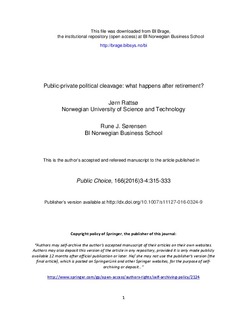Public-private political cleavage: what happens after retirement?
Journal article, Peer reviewed
Permanent lenke
http://hdl.handle.net/11250/2393064Utgivelsesdato
2016Metadata
Vis full innførselSamlinger
- Scientific articles [2181]
Sammendrag
Political preferences of public employees differ from those of workers in the private sector. The former are more likely to vote for left-wing parties and orient themselves ideologically towards the left. This political cleavage can be understood as the result of occupational incentives, or alternatively, as ideological self-selection whereby individuals favoring government solutions seek employment in the public sector. We test the selection hypothesis by estimating the effects of public versus private occupational sector on political preferences before and after retirement. The data are from the Norwegian Election Surveys and cover nine national elections between 1977 and 2009. The research design addresses a series of cross-sectional data and the key challenge of endogenous retirement is handled with instrumental variables. Party choice, ideological orientation, and public spending preferences are shown to change following retirement, and former private and public employees converge. The results reject selection based on ‘hard-wired’ political preferences.
Beskrivelse
This is the author’s accepted and refereed manuscript to the article
